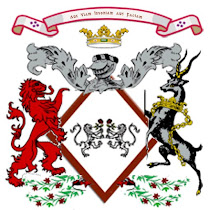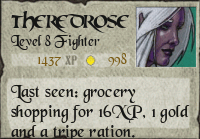
Ecce Chorus Virginum
Here be maids dancing
in the spring days.
April light lancing
long level rays.
In this fair valley
fragrant and sweet
is a bright alley
with lilies deep
where the gay blackbird
pipes all day long
sweetness recordeth
the nightingale’s song.
Here come the virgins
flower garlanded.
But who shall sing then
that blaze of beauty,
love’s secret store?
Tales of old sorrow
grieve us no more.
Peace to your piping
with linden bought
at beauty’s altar
pay ye your vows.
(in the original Latin)
ecce chorus virginum
tempore vernali
dum solis incendium
radios equali
in hac valle florida
floreus flagratus
inter septa lilia
locus purpuratus
dum garritus merule
dulciter alludit
philomena carmine
dulcia concludit
acies virginea
redimita flore
quis enarret talia
quantoque decore
prenitent ad libitum
veneris occulta
dido necis meritum
proferat inulta
moderatur ordine
iubilo semoto
fronde pausa tilie
cypridis in voto

Apr 28, 2010
More Beltane Inspired Poetry
Posted by Eva Bellambi at 10:22 PM 1 comments
Labels: Beltane, Eva Bellambi, poetry
Apr 24, 2010
Beltane Inspired Poetry from The Red Rose
As I worked on music tonight for the Beltane ceremony and the ceilidh that will follow it, I came across several lyrics and poems that I would like to share over the course of this coming week. I hope that these words might speak to some of you as we find ourselves nearing the changing of the seasons.
Suscipe Flos Florem
(from the manuscript of Benedictbeurern)
Suscipe Flos florem,
quia flos designat amorem
illo de flore
nimio sum captus amore.
Hunc florem, Flora
dulcissima, semper odora!
nam velut aurora
fiet tua forma decora.
florem, Flora, vide,
quem dum videas, mihi ride!
Florem Flora tene,
tua vox cantus philomene.
oscula des flori,
rubeo flos convenit ori.
Flos in pictura
non est flos, immo flgura ;
qui pingit florem
oscula des flori,
rubeo flos convenit ori.
[English Translation]
Take thou this rose, O Rose
since love’s own flower it is
and by that rose
thy lover captive is.
Smell thou this rose, O Rose
and know thyself as sweet
as dawn is sweet.
Look at this rose, O Rose
and looking, laugh on me
and in thy laughter’s ring
the nightingale shall sing.
Kiss thou this rose, O Rose
that it may know
the scarlet of thy mouth.
O Rose, this painted rose
is not the whole
who pains the flower
paints not its fragrant soul.

Posted by Eva Bellambi at 11:57 PM 0 comments
Apr 19, 2010
4th Annual Beltane Celebration

In Scottish Gaelic the month of May is known as either (An) Cèitean or a' Mhàigh, and the festival is known as Latha Bealltainn or simply Bealltainn - meaning ‘bright/sacred fire’. The holiday was held to mark and celebrate the blossoming of spring, and coincided with the ancient pastoral event of moving livestock into their summer grazing fields. It did not occur on any fixed solar date (the tradition of solstices and equinoxes is later in origin) but tended to be held on the first full moon after the modern 1st of May. Some sources suggest that the blooming of the Hawthorn was the primary signal for the event before the development of centralized calendars.
It was nearly entirely a celebration of the fertility of the land and their animals. The main traditional element which was common to all Beltane festivals was the fire which gave it its name. All the fires of the community would be extinguished and a new, sacred ‘Need Fire’ was lit by either the village head or spiritual leader. From this source one or two bonfires were lit, and the animals of the community would be driven through or between them. It was believed that the smoke and flame of the fires would purify the herd, protecting them in the year to come and ensuring a good number of offspring. The inhabitants of the village would then take pieces of the fire to their homes and relight their hearths, and dance around or near the bonfires to ensure good portents for them and their families.
This spring/summer rite was celebrated in many ancient cultures. Some continue it even in modern times. In many traditions the focus of Beltane is on the battle between the May Queen and the Queen of Winter. The May Queen can be recognized as Flora, the goddess of the flowers, and the young blushing bride, and the princess of the Fae. She is Lady Marian in the Robin Hood tales, and Guinevere in the Arthurian cycle. She is the embodiment of the Maiden, of mother earth in all of her fertile glory. Beltane has a long history. The Celtic fire festival is celebrated with bonfires, Maypoles, dancing, and lots of good old fashioned sexual energy. In Ireland, the fires of Tara were the first ones lit every year at Beltane, and all other fires were lit with a flame from Tara.
The Romans celebrated the Floralia, or festival of flowers, which consisted of three days of unbridled sexual activity. Participants wore flowers in their hair (much like May Day celebrants later on), and there were plays, songs, and dances. At the end of the festivities, animals were set loose inside the Circus Maximus. Land owners would have often have sex in their fields to ensure the fertility of their lands.
The entity known as the Green Man, strongly related to Cernunnos (The Horned God), is often found in the legends and lore of the British Isles, and is a masculine face covered in leaves and shrubbery. In some parts of England, a Green Man is carried through town in a wicker cage as the townsfolk welcome the beginning of summer. Impressions of the Green Man’s face can be found in the ornamentation of many of Europe’s older cathedrals, despite edicts from local bishops forbidding stonemasons from including such pagan imagery.
A related character is Jack-in-the-Green, a spirit of the greenwood. References to Jack appear in British literature back as far as the late sixteenth century. Sir James Frazer associates the figure with mummers and the celebration of the life force of trees. Jack-in-the-Green was seen even in the Victorian era, when he was associated with soot-faced chimney sweeps. At this time, Jack was framed in a structure of wicker and covered with leaves, and surrounded by Morris dancers. Some scholars suggest that Jack may have been a ancestor to the legend of Robin Hood.
This festival is also seen as a time when the veil between worlds is a bit thinner - a time for the faeries. The appearance of flowers around this time of year heralds the beginning of summer and shows us that the fae are hard at work. In early folklore, the more helpful deeds of the fae should always be acknowledged and appreciated, therefore, Beltane offered a good time to leave out food and other treats for them in your garden or yard.
As is my custom, we will begin the evening with a celebration of my Clan and the Knights of the Order of the Red Rose, and then lighting of the Beltane Need Fire. Each guest will also be offered a Beltane lamp which will light as s/he approaches the Need Fire. This light should be taken to his/her own hearth at the end of the festival.
As is always the case, I invite you to let go of the formality of day to day life and celebrate freely the renewal of the earth, the fertility of your lands, your livestock, yourselves. Release your inner, May Queen, Green Man, White Lady, Blue Man, Roman God/Goddess, or Færiekind. Dress is quite relaxed - and clothing generally becomes optional as the fever pitch around the fire grows. There will be discrete areas available for your own fertility rites to be celebrated.
**Text drawn & edited from prior years' blog posts about my celebration.
Posted by Eva Bellambi at 5:19 PM 0 comments
Labels: Beltane, Isle of Skye, Winterfell Anodyne
Apr 13, 2010
Shall We Visit the Man in the Moon?
 The inspiration for the post of these lyrics: Onxy Plutonian's Airship.
The inspiration for the post of these lyrics: Onxy Plutonian's Airship.I had a very nice time dancing with a few friends and new acquaintances last evening inside this lovely ship.
COME TAKE A RIDE
(In My Airship)
by Ren Shields
I love a sailor, a sailor loves me. He comes every night to my home
He’s not a sailor who sails on the sea over the wild briny foam
For he owns an airship that sails upon high.
He’s just like a bird on the wing.
And every evening when shadows draw nigh,
he will come to my window and sing:
Come take a ride in my airship. Come take a trip to the stars.
Come take a ride around Venus. Come take a trip around Mars.
No One to watch while we’re kissing. No one to see while we spoon.
Come take a ride in my airship and we’ll visit the man in the moon.
One night while out sailing away from the stars
We passed through the milk-y white way.
Just idly sailing and watching the stars
he asked me if I’d name the day.
Right near the dip-per I gave him my heart.
The sun shines on our honey-moon.
We swore to each other we
never would part and we’d teach all our babies this tune:
Come take a ride in my airship. Come take a trip to the stars.
Come take a ride around Venus. Come take a trip around Mars.
No One to watch while we’re kissing. No one to see while we spoon.
Come take a ride in my airship and we’ll visit the man in the moon.
Posted by Eva Bellambi at 9:07 AM 0 comments
Labels: Airship, Onxy Plutonian, poetry
Apr 7, 2010
A Little Southern Humor
A bit of story-telling inspired by the character I portrayed at the Cinema party in New Babbage this week.
Posted by Eva Bellambi at 10:02 AM 0 comments
Apr 3, 2010
A Blessed Easter to All My Christian Friends
Deep Peace (A Gaelic Blessing)
Deep peace of the running wave to you
Deep peace of the flowing air to you
Deep peace of the quiet earth to you
Deep peace of the shining stars to you
Deep peace of the gentle night to you
Moon and stars pour their healing light on you
Deep peace of Christ, of Christ
The light of the world to you
Deep peace of Christ to you
Beannachd Dia dhuit, mo charaid.
Posted by Eva Bellambi at 5:52 PM 0 comments








